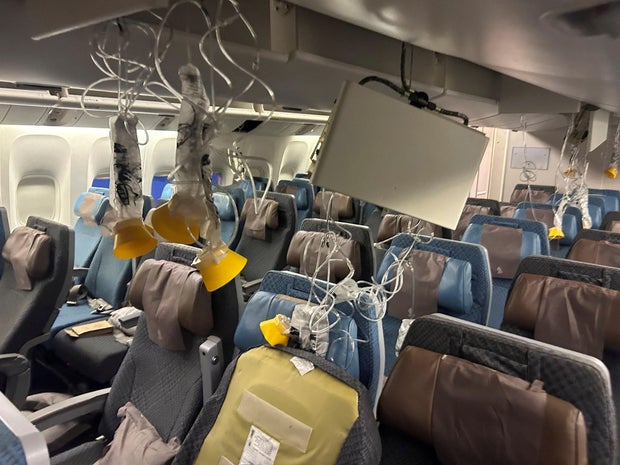Video and passenger accounts have painted a picture of chaos aboard Singapore Airlines Flight SQ321 after the passenger aircraft encountered what the airline called “sudden extreme turbulence.”
One person died during the incident. Authorities believe the passenger, identified as a 73-year-old British man, had a heart attack. Dozens of other passengers were injured. Six people were treated for serious injuries after the plane made an emergency landing in Bangkok, Thailand. CBS News previously reported.
The incident drew attention to the dangers that turbulence can pose. One type of turbulence, known as clear air turbulence, can be especially difficult for pilots.
Here’s what you should know about clear air turbulence.
What is clear air turbulence?
Clear-air turbulence is a “typically very violent” phenomenon that occurs at high altitudes, typically between 23,000 and 39,000 feet above sea level, said Hassan Shahidi, president and CEO of the Flight Safety Foundation.
What makes clear-air turbulence dangerous is that it cannot be seen in advance like weather-driven turbulence, known as convective turbulence. Typically, flights divert or enter a holding pattern to avoid severe turbulence, but if it can’t be seen in advance, pilots won’t be able to adjust to avoid it, Shahidi said.
Reuters/Stringer
What causes turbulence in clear air?
Airplanes often fly through air masses known as jet streams. Within these streams, there are multiple layers of air flowing at varying speeds “almost over each other,” said Daniel Adjekum, a pilot and aircraft safety consultant who holds a doctorate in aerospace science and teaches at the University of North Dakota. Different temperatures cause friction. That friction, in turn, causes “a lot of disruption,” Adjekum said.
In convective turbulence, caused by thunderstorms or other weather conditions, air is heated and displaced, leading to high moisture content that can be easily detected on flight instruments. Turbulence in clear air doesn’t have this high level of moisture, so radar and other instruments can’t detect it until it’s too late, Adjekum said.
“That’s what makes it very insidious,” Adjekum said.
Climate change also plays a role. Warmer air caused by carbon dioxide emissions is leading to stronger wind shear at higher altitudes, which can result in clear air turbulence. A 2023 study found that clear air turbulence increased 41% over the last 40 years.
Is clear-sky turbulence to blame for the chaos on board flight SQ321?
Experts were hesitant to say whether clear-sky turbulence was to blame for the scene aboard Singapore Airlines flight SQ321. The airline said the deaths and injuries on board the plane were caused when the aircraft “encountered sudden extreme turbulence.”
The plane was flying at 37,000 feet, the airline said, putting it in the clear air turbulence range, but experts highlighted thunderstorms in the area that could have caused the turbulence.
Robert Sumwalt, former chairman of the National Transportation Safety Board and a pilot, told CBS Evening News that it is “too early to know for sure” what caused the incident.
An investigation is ongoing.
Is there a forecast for clear air turbulence?
The unpredictability of clear-air turbulence makes prediction difficult, although it is more common during the winter months.
Experts say the best way to prepare for the phenomenon is to keep your seat belt on while flying.
If you are not actively moving around the cabin, your seat belt should be on, Adjekum said. If the pilot activates the fasten seat belt signal, all passengers must return to their seats as quickly as possible.
Kris Van Cleave and Tracy Wholf contributed to this report.
























